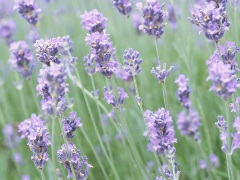Features
Lavender-scented biofuels
Date: 2018-08-16 14:55:22.0
Author: Jon Evans

The attractive floral fragrances of perfumes, cosmetics and soaps are mainly down to plant-derived essential oils, which can also be used to flavor food and drink. These essential oils are produced by extracting volatile aroma compounds from raw plant material, including flowers, leaves and stems, via distillation.
Given the size of the perfume and cosmetic industries, it’s no surprise that the production of essential oils is a major business. But because aroma compounds only make up a small percentage of raw plant material, between 1% and 10% of dry matter, essential oil production generates a lots of waste material.
Traditionally, this waste material is simply burnt or dumped, but, as with much other agricultural waste, scientists are now beginning to investigate its potential as a feedstock for biofuels and biochemicals. What makes this material particularly interesting as a feedstock is that it has already been partially broken down by the distillation step, which involves exposing the raw material to steam. The distilled material left over from this step should be easier to convert into biofuels and biochemicals.
This is what a team of Indian scientists led by Prasant Rout from CSIR-Central Institute of Medicinal and Aromatic Plants in Lucknow discovered when studying the leftover distilled material generated by the production of menthol mint from the flowing plant Mentha arvensis. Indian farmers are the main growers of M. arvensis, responsible for around 60% of world production, which generates four million tons of leftover distilled material a year.
Because the distilled material was already partially broken down, Rout and his team were able to design a cheap and simple method for extracting cellulose from it. This involved treating the material first with a mixture of the solvents hexane and methanol to break it down further, and then with a weak solution of sodium hydroxide to release the cellulose.
As Rout and his team report in a paper in Industrial Crops and Products, this method produced a good yield of cellulose, amounting to 38% of the distilled M. arvensis material. They also showed that this cellulose could be readily converted by fungal enzymes into glucose for fermentation into ethanol.
But it’s not just cellulose that can be extracted from the leftover distilled material, because, depending on the plant, this material can contain a whole load of other interesting compounds as well. This is what a team of scientists from France and Spain, led by Anne Lomascolo from Aix-Marseille University, discovered when they investigated distilled leftover lavender material.
Lavender is the common name for species of the Lavandula genus of flowering plant, which produce one of the most widely used essential oils. France is the main producer of lavender essential oil, derived mainly from L. angustifolia and its hybrids, which results in the creation of around 20,000 tons of leftover lavender material each year.
As Lomascolo and her team report in a paper in Biotechnology for Biofuels, their study showed that cellulose could be extracted from both the distilled lavender flowers and stems. However, the stems yielded about twice as much cellulose (around 17% of dry matter) as the flowers (around 8%). Next, they used a solvent-based process to extract a range of other interesting chemical compounds from the lavender material, including known anticancer, anti-inflammatory and antimicrobial compounds. This process was able to also to extract vanillic, coumaric and ferulic acids, which can be converted into various industrial chemicals.
Lomascolo and her team therefore conclude that distilled lavender material has great potential for use as a feedstock for various valuable chemicals, offering an additional source of revenue for essential oil producers. This is also the conclusion of a team of scientists in the US led by Valtcho Zheljazkov at Oregon State University. In a paper in the Journal of Agricultural and Food Chemistry, they report that distilled leftover material from the production of essential oils from four plants – three Mentha mint species and sweet sagewort (Artemisia annua) – can yield similar amounts of ethanol as switchgrass.
The views represented here are solely those of the author and do not necessarily represent those of John Wiley and Sons, Ltd. or of the SCI.
This article has not been tagged with keywords.
